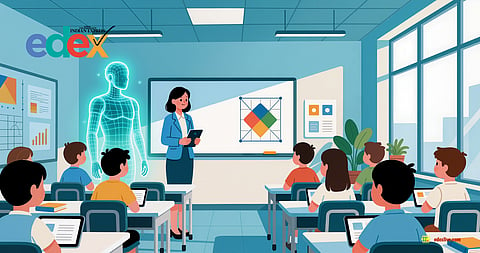

Education has always evolved with technology, but the pace at which artificial intelligence (AI) has entered classrooms marks a turning point. What was once an idea of the future is now a visible force shaping how teachers teach and how students learn. The presence of AI in education is not about replacing human effort—it is about creating a more adaptive, insightful, and personalized environment for every learner. For educators, this shift has opened new avenues to make teaching more efficient, inclusive, and engaging than ever before. In fact, over 70% of Indian teachers now use AI tools, underscoring how rapidly this transformation is redefining modern classrooms.
Teachers today are increasingly supported by AI-driven digital ecosystems that simplify lesson delivery, and classroom management. Intelligent systems assist in planning lessons, assessing performance, and identifying students who may need additional guidance.
With interactive displays and smart LED projectors, educators can now blend AI-enabled content with visual learning tools — turning static lessons into dynamic, participative experiences.
These technologies also allow teachers to annotate, record, and share lessons easily, helping them create a more engaging and collaborative classroom environment.
AI complements this by suggesting content or generating quizzes aligned with specific learning objectives. By automating routine work, teachers gain the freedom to focus on creativity, dialogue, and mentoring. Ultimately, AI is helping educators shift from administrative execution to purposeful teaching.
AI’s most significant strength lies in personalisation. Adaptive learning platforms can analyse how students interact with digital lessons and adjust the difficulty level, pace, or type of content accordingly. For instance, when paired with interactive displays, AI can prompt teachers with real-time feedback — indicating which topics need more attention or which students may benefit from additional visual explanations.
This combination of intelligent insight and visual technology encourages participation from every learner. For students with language or learning challenges, AI-enabled voice recognition, translations, and visual cues ensure inclusivity. Smart classroom tools, powered by AI, thus bridge the gap between diverse learning needs — helping teachers reach each student in ways that traditional methods could not.
The integration of AI with connected classroom technology is shaping the schools of tomorrow. Data-driven insights help educators refine curricula and measure progress with precision, while collaborative tools foster teamwork and critical thinking.
Modern classrooms equipped with interactive panels, wireless sharing tools, and cloud-based software create an environment where students are not just passive listeners but active participants.
As students engage with AI-assisted lessons, they also develop familiarity with the technologies defining the future workplace — machine intelligence, data interpretation, and digital communication. This exposure prepares them for a world where adaptability and problem-solving are as vital as subject knowledge.
Conclusion
AI’s growing role in classrooms signifies more than just a technological upgrade — it represents a new era of empowered teaching and meaningful learning. When supported by intelligent, visual, and connected classroom solutions, educators can focus on what truly matters: inspiring curiosity, nurturing understanding, and building future-ready learners.
The future of education will continue to rely on this powerful partnership between human insight and intelligent technology — where AI serves not as a substitute, but as a trusted ally in shaping brighter minds.
(Written by Muneer Ahmad, Vice-President, AV Business, ViewSonic India. Views expressed are their own)
